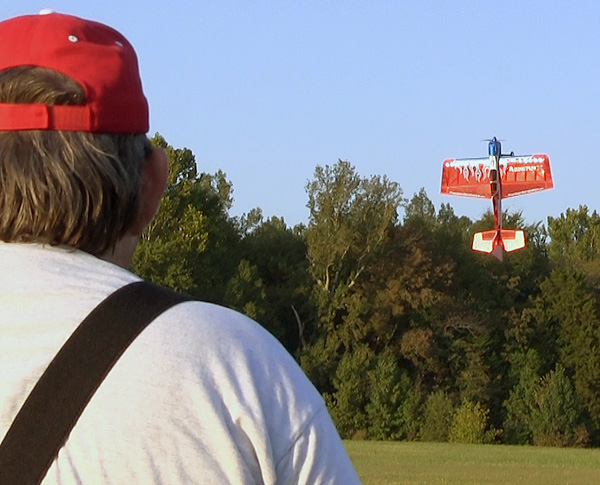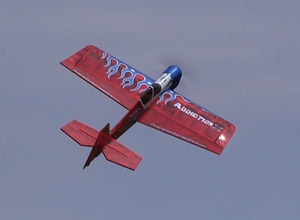



When I started flying RC there was no such thing as 3D flying. Now 40-some years
later I am hopeful of perhaps getting to 1-1/2D status...maybe.
Text, photos and video by Tom Hintz
Posted – 10-7-2013
When I flew Radio Control airplanes back then I considered myself a sport flier. I had no interest in pattern flying or sailplanes and though I did fly quite a bit of quarter scale I refused to fall into the clutches of the giant scale purist mentality of the time. Today though I have many of the same piloting aspirations the hobby has evolved to where there are more genres of aircraft and piloting skill sets from which to pick. Most notable amongst modern day disciplines is 3-D flying. There were some pilots back 25 years ago that were doing odd things with airplanes, many of us could “hang it on the prop”, what we called hovering back then but the planes and equipment of the period were very limiting and just would not support much of what we see today.
While there is a strong segment of the RC population that are understandably fully dedicated to 3-D flying and others equally loyal to scale flying, pattern, sail planes, control line and the rest, I think that the general sport flier remains the backbone of the RC community both in pure numbers and probably dollars spent in the RC marketplace. I am finding that given the incredible planes offered today there are many of these sport fliers whom like me fall into what I call D and a Half Flying for lack of a better term.
Fueling the growth of D and a Half pilots is the wealth of ARF (almost ready to fly) aircraft with huge performance envelopes. I discovered these planes when I saw my first Precision Aerobatics Addiction X at our (RC Wingers, Mooresville NC AMA #1462) flying field. Not long after I had my own Addiction X and was experiencing firsthand the wide-ranging capabilities that plane had that exceed pure 3-D flying in a big way.
The very traits that make these planes 3-D capable also make them great learning platforms with the flick of a dual rate switch for the novice and more sport minded pilots. While I was exploring the world of thrashing a plane around the sky at ridiculously low speeds I noticed that I was not alone in flirting with the edges of 3-D while staying in my comfortable sport-flying world. The two disciplines seemed to merge somewhere within the immense flight envelope of the Precision Aerobatics Addiction X but most who were flying them continued to enjoy general sport aviation. Many are taking advantage of the Addiction X’s capabilities and adding some 3-D routines to their personal flight envelope but they consider themselves sport, not 3-D pilots. And that is OK.
I like to know what makes things do what they do so began pondering the attributes of my Precision Aerobatics Addiction X. It became obvious that the laser-cut and jig assembled structure is very rigid yet remarkably light. Combine that with a huge wing area, super exact factory-set incidence and you get a plane that precise and responsive even at lower speeds. The overall maneuverability of planes like the Precision Aerobatics Addiction X may have been designed with 3-D in mind but those characteristics also make these planes much easier to fly for newer pilots with the self-control to stick with lower rates for a while. The lower speeds give pilots far longer to think about what they are doing and what to do to correct a situation. The Precision Aerobatics Addiction X flies is so stable at very low speeds that a squirt of throttle instantly stabilizes it in most attitudes. I have totally lost it with the tail less than a foot off the grass and simply gassed it to bail out, go up, gather my wits and try it again. I have also flopped my Addiction X onto the grass several times with little or no damage when I worked myself into situations where even gassing it was not smart. The Precision Aerobatics Addiction X huge flight envelope meant that there was virtually no forward motion so most times no damage to the plane! In most cases that I have heard from other Precision Aerobatics Addiction X pilots (and fliers of other planes made by Precision Aerobatics) if there was damage it seemed to always be minimal and often repairable at the field.

Modern ARF models make owning a
3d capable plane much easier.
I also have the Precision Aerobatics Extra MX that has many of the same slow-speed capabilities as the Precision Aerobatics Addiction X but with the power to take off and immediately go vertical until it is no longer visible. That sets the electric flight non-believers on their collective butts. However, it features the same light, rigid construction and large wing area that let it float along with control at walking speed.
For the new fliers it is the slow speed stability that is so nice. Even takeoffs and landings can be done with full control at half the speed of regular airplanes. That removes some of the pressure on the student pilot and gives the instructor more latitude when teaching. I have been able to let new pilots fly much farther into their initial landings than ever before because of the lower speeds and ease with which I can save the plane when they make the same rookie mistakes that we all did.
Flying RC airplanes has always been lots of fun. Today with the power and convenience of the electric powered planes like the Precision Aerobatics Addiction X and their Extra MX (and others, their lineup of planes keeps growing) you can expand the capabilities of your air wing and at the same time widen the comfort zone within your flight envelope that lets you have a good time in this hobby/sport.
I see nothing but good things in the future for D and a Half pilots. If the offerings of Precision Aerobatics are at all representative of the market the planes and radios keep getting better in terms of flight characteristics and in-air capabilities. That leaves lots more time for the D and a Half pilots to learn what they want to learn in terms of aerobatics and skip over the rest. We all get to decide what we like to do with a model airplane but the more the plane is capable of and the easier it makes doing those things for us D and a Half pilots the better we feel about the hobby.
3D and all of the more traditional disciplines that make up radio control flying will continue to grow but I think the D and a Half pilots segment is the real mover here. People like to have a good time while pursuing a hobby and the modern planes and equipment make that easier to do and often cheaper than in the not-so-distant past. All you have to do is join a club (and the AMA), learn to fly and then work on having a good time.
Have a comment on this story? –Email Me!
Visit the Precision Aerobatics web page – Click Here